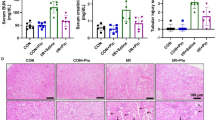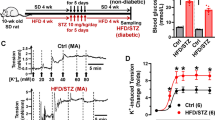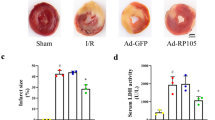Abstract
Endothelial progenitor cells (EPCs) play an important role in postnatal neovascularization and re-endothelialization in response to tissue ischemia and endothelial injury. It is reported that the circulating EPCs number is decreased during hypertension. However, the detailed mechanism is still unclear. Our previous studies have shown that ClC-3 chloride channel is up-regulated with the development of hypertension. This study aims to test whether ClC-3 participates in EPC apoptosis under the condition of increased oxidative stress in angiotensin II (Ang II)-induced hypertension. The results showed that stimulation with 10−6mol/L Ang II significantly up-regulated the endogenous ClC-3 expression and increased intracellular reactive oxygen species (ROS) generation in EPCs of wild type mice, accompanied by an enhanced NADPH oxidase activity and the expression of gp91phox (NOX-2), a key catalytic subunit of NADPH oxidase. However, these effects of Ang II were significantly reduced in EPCs of ClC-3−/− mice. Compared with control, treatment with Ang II induced EPCs apoptosis in wild type mice, concomitantly with declined Bcl-2/Bax ratio, depressed mitochondrial membrane potential and activation of poly(ADP-ribose) polymerase, which was remarkably prevented by both ClC-3 knockout and NADPH oxidase inhibitor apocynin. In addition, the role of ClC-3 deficiency in protecting EPCs against Ang II-induced oxidative stress and apoptosis was further confirmed in Ang II-infused hypertensive mice in vivo. In conclusion, ClC-3 deficiency inhibited Ang II-induced EPC apoptosis via suppressing ROS generation derived from NADPH oxidase.








Similar content being viewed by others
References
Lamping K (2007) Endothelial progenitor cells: sowing the seeds for vascular repair. Circ Res 100:1243–1245
Giannotti G, Doerries C, Mocharla PS, Mueller MF, Bahlmann FH, Horvàth T et al (2010) Impaired endothelial repair capacity of early endothelial progenitor cells in prehypertension: relation to endothelial dysfunction. Hypertension 55:1389–1397
Chen DD, Dong YG, Yuan H, Chen AF (2012) Endothelin 1 activation of endothelin A receptor/NADPH oxidase pathway and diminished antioxidants critically contribute to endothelial progenitor cell reduction and dysfunction in salt-sensitive hypertension. Hypertension 59:1037–1043
Marrotte EJ, Chen DD, Hakim JS, Chen AF (2010) Manganese superoxide dismutase expression in endothelial progenitor cells accelerates wound healing in diabetic mice. J Clin Invest 120:4207–4219
Ceradini DJ, Yao D, Grogan RH, Callaghan MJ, Edelstein D, Brownlee M, Gurtner GC (2008) Decreasing intracellular superoxide corrects defective ischemia-induced new vessel formation in diabetic mice. J Biol Chem 283:10930–10938
Yao EH, Fukuda N, Matsumoto T, Kobayashi N, Katakawa M, Yamamoto C et al (2007) Losartan improves the impaired function of endothelial progenitor cells in hypertension via an antioxidant effect. Hypertens Res 30:1119–1128
Guan YY, Wang GL, Zhou JG (2006) The ClC-3 Cl− channel in cell volume regulation, proliferation and apoptosis in vascular smooth muscle cells. Trends Pharmacol Sci 27:290–296
Nilius B, Droogmans G (2003) Amazing chloride channels: an overview. Acta Physiol Scand 177:119–147
Qian Y, Du YH, Tang YB, Lv XF, Liu J, Zhou JG, Guan YY (2011) ClC-3 chloride channel prevents apoptosis induced by hydrogen peroxide in basilar artery smooth muscle cells through mitochondria dependent pathway. Apoptosis 16:468–477
Zhang HN, Zhou JG, Qiu QY, Ren JL, Guan YY (2006) ClC-3 chloride channel prevents apoptosis induced by thapsigargin in PC12 cells. Apoptosis 11:327–336
Hawkins BJ, Madesh M, Kirkpatrick CJ, Fisher AB (2007) Superoxide flux in endothelial cells via the chloride channel-3 mediates intracellular signaling. Mol Biol Cell 18:2002–2012
Miller FJ Jr, Filali M, Huss GJ, Stanic B, Chamseddine A, Barna TJ, Lamb FS (2007) Cytokine activation of nuclear factor kappa B in vascular smooth muscle cells requires signaling endosomes containing Nox1 and ClC-3. Circ Res 101:663–671
Ushio-Fukai M, Urao N (2009) Novel role of NADPH oxidase in angiogenesis and stem/progenitor cell function. Antioxid Redox Signal 11:2517–2533
Endtmann C, Ebrahimian T, Czech T, Arfa O, Laufs U, Fritz M et al (2011) Angiotensin II impairs endothelial progenitor cell number and function in vitro and in vivo: implications for vascular regeneration. Hypertension 58:394–403
Okamoto F, Kajiya H, Toh K, Uchida S, Yoshikawa M, Sasaki S et al (2008) Intracellular ClC-3 chloride channels promote bone resorption in vitro through organelle acidification in mouse osteoclasts. Am J Physiol Cell Physiol 294:C693–C701
Oliver FJ, de la Rubia G, Rolli V, Ruiz-Ruiz MC, de Murcia G, Murcia JM (1998) Importance of poly(ADP-ribose) polymerase and its cleavage in apoptosis: lesson from an uncleavable mutant. J Biol Chem 273:33533–33539
Tongers J, Losordo DW, Landmesser U (2011) Stem and progenitor cell-based therapy in ischaemic heart disease: promise, uncertainties, and challenges. Eur Heart J 32:1197–1206
Imanishi T, Moriwaki C, Hano T, Nishio I (2005) Endothelial progenitor cell senescence is accelerated in both experimental hypertensive rats and patients with essential hypertension. J Hypertens 23:1831–1837
Hill JM, Zalos G, Halcox JP, Schenke WH, Waclawiw MA, Quyyumi AA, Finkel T (2003) Circulating endothelial progenitor cells, vascular function, and cardiovascular risk. N Engl J Med 348(7):593–600
Imanishi T, Hano T, Nishio I (2005) Angiotensin II accelerates endothelial progenitor cell senescence through induction of oxidative stress. J Hypertens 23:97–104
Shi XL, Wang GL, Zhang Z, Liu YJ, Chen JH, Zhou JG, Qiu QY, Guan YY (2007) Alteration of volume-regulated chloride movement in rat cerebrovascular smooth muscle cells during hypertension. Hypertension 49:1371–1377
Liu YJ, Wang XG, Tang YB, Chen JH, Lv XF, Zhou JG, Guan YY (2010) Simvastatin ameliorates rat cerebrovascular remodeling during hypertension via inhibition of volume-regulated chloride channel. Hypertension 56:445–452
Yang H, Huang LY, Zeng DY, Huang EW, Liang SJ, Tang YB et al (2012) Decrease of intracellular chloride concentration promotes endothelial cell inflammation by activating nuclear factor-kappa B pathway. Hypertension 60:1287–1293
Wilkinson-Berka JL, Rana I, Armani R, Agrotis A (2013) Reactive oxygen species, Nox and angiotensin II in angiogenesis: implications for retinopathy. Clin Sci (Lond) 124:597–615
Moreland JG, Davis AP, Matsuda JJ, Hook JS, Bailey G, Nauseef WM, Lamb FS (2007) Endotoxin priming of neutrophils requires NADPH oxidase-generated oxidants and is regulated by the anion transporter ClC-3. J Biol Chem 282:33958–33967
Brady HJ, Gil-Gomez G (1998) The pro-apoptotic Bcl-2 family member, Bax. Int J Biochem Cell Biol 30:647–650
Green DR, Reed JC (1998) Mitochondria and apoptosis. Science 281:1309–1312
Tang YB, Liu YJ, Zhou JG, Wang GL, Qiu QY, Guan YY (2008) Silence of ClC-3 chloride channel inhibits cell proliferation and the cell cycle via G/S phase arrest in rat basilar arterial smooth muscle cells. Cell Prolif 41:775–785
Acknowledgments
This work was supported by the Natural Science Foundation of China (Grant No. 30900578); and Science and Technology Planning Project of Guangzhou City, China (Grant No. 2011J2200077).
Author information
Authors and Affiliations
Corresponding author
Additional information
Jing Liu and Fei-Fei Zhang contributed equally to this study.
Rights and permissions
About this article
Cite this article
Liu, J., Zhang, FF., Li, L. et al. ClC-3 deficiency prevents apoptosis induced by angiotensin II in endothelial progenitor cells via inhibition of NADPH oxidase. Apoptosis 18, 1262–1273 (2013). https://doi.org/10.1007/s10495-013-0881-z
Published:
Issue Date:
DOI: https://doi.org/10.1007/s10495-013-0881-z




